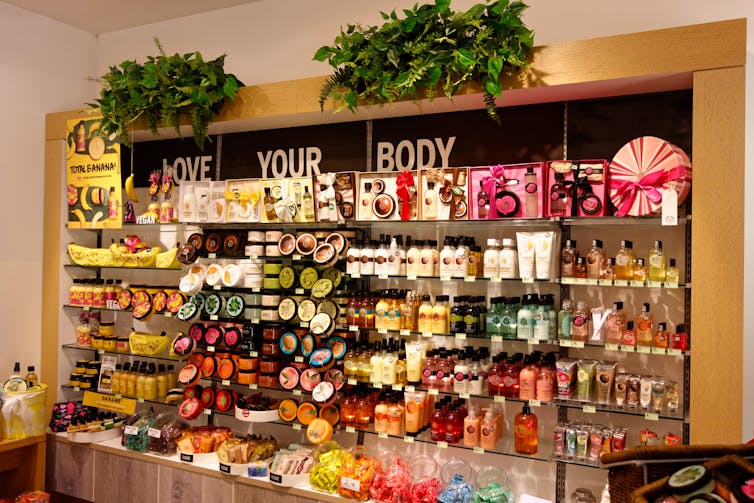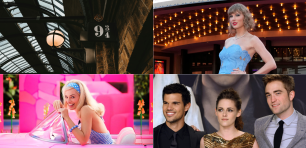
Source: Adobe Stock.
I’m exactly the right age (46) to look back with nostalgia on the significant part that The Body Shop played in my teen years. I can clearly remember the excitement of Saturdays in town, scraping pennies together to buy little pots of fruit-scented eye gel or lip balm, and the fact that every single house party smelled, not like Teen Spirit, but of White Musk, a popular Body Shop perfume, whose scent came to encapsulate the 90s.
In the late 1980s and early 1990s, there were few beauty brands that spoke to young people the way that The Body Shop did. They were radical, they cared about animal testing (which was pretty much ubiquitous at the time) and everything smelled so sweet and fruity.
My teenage birthday and Christmas present lists were stacked with Body Shop products, and once tried, they became beauty staples, used over years and decades. I still use Body Shop products today. The Vitamin E skincare range is perfect for my English rose complexion and the bronzing palette gives me a healthy glow.
Much has been said about the mistakes made and why the brand has ultimately failed but, as an expert in marketing, I believe it gave a lot to women of my generation, and its values still resonate. That’s why I’m optimistic it could still have a future.
A genuine alternative
Firstly, it was a female-led business. Dame Anita Roddick was a trailblazer for successful, high-profile female entrepreneurs, starting The Body Shop in the late 1970s and nurturing it onto every high street by the late 1980s. And she hadn’t just made it in a man’s world, she’d done it without compromising her principles.
After a decade of Margaret Thatcher (the UK’s first female, and very divisive, prime minister who embodied The Cold War generation), we young women needed role models like Anita Roddick. She chimed perfectly with the 90s “girl power”, she was overtly feminist and ran a successful business that felt radical, young and somehow rebellious.
Secondly, we felt a sense of ownership and buy-in with The Body Shop brand that I suspect is lacking in later generations. It genuinely felt like a brand that was for us. It cared about animal testing, it was one of the first major proponents of fair trade (since 1987) and it used refills and minimal packaging.
The Body Shop showed that there was an alternative to fast consumerism, that there was a better, kinder way of doing business. In many ways, it was decades ahead of the curve. Other beauty brands are only now treading the path it wore smooth over 40 years.
But it was the fact that you could be a feminist and an eco-warrior and still look and smell great that really drew many of us in. The body butters felt great and the perfumes smelled incredible, and we could have it all – guilt-free. We were going to show the older generation just how it was done, with our careers, and families, and our principles.
Over to gen Z
Now reality has hit home for The Body Shop, as well as for the rest of us. Having it all was a myth that ultimately led to failure. But there is a part of me that still believes in the brand.
I hope this isn’t really the end of The Body Shop. It retains its bold vision and still makes strong, well-loved products. Perhaps it needed a little more love from its venture capital owners, and maybe there are other, brave, young people who can return it to its former glory.
My advertising and marketing communications students seem to exude all those values that The Body Shop inspired. Aren’t gen Z perfectly placed to lead the brand forward given its values-driven stance? Which should appeal so much to young people, based on what we know of them as consumers. So it shouldn’t take a huge shift in product development but more of a re-positioning and brand refresh.

The many scents of The Body Shop eco-friendly products remain nostalgic reminders of teenage years in the 90s and early 2000s. Source: Shutterstock/Sergej Lebedev
In fact, I think there’s some quick wins the brand could make to increase its visibility with young people. Firstly, it needs to invest heavily in social media advertising and influencer marketing. The way that young people shop differs significantly from previous generations and they rely on social media for new products, reviews and make-up demonstrations.
Also, it needs a cohesive e-commerce presence. For example, I am a Body Shop customer who visits the website and I can’t remember the last time I saw them on Facebook, Instagram or TikTok, which suggests they aren’t using re-marketing effectively.
The brand would need to connect with young people in the way it did with our generation. It actually already has some great campaigns – for example, votes for 16 and 17-year-olds. But where are the young people themselves? It all feels a bit corporate rather than the grassroots authentic activism young people are used to.
Gen Z and millennials are obsessed with the 90s. The clothes, the food and the music are back in style in a big way, with combat trousers, crop tops and platform shoes all making a comeback. And what’s more 90s than The Body Shop? The power of nostalgia could help re-invent this struggling brand.
I can’t help but think that young entrepreneurs taking it over and re-hauling it would be a more fitting end for The Body Shop story.
Caroline Spence is a senior lecturer and programme leader in the Department of Business and Law at De Montfort University.
This article is republished from The Conversation under a Creative Commons license. Read the original article.
Handpicked for you

Influencer leak turns into publicity gold for Tbh Skincare’s latest product launch



COMMENTS
SmartCompany is committed to hosting lively discussions. Help us keep the conversation useful, interesting and welcoming. We aim to publish comments quickly in the interest of promoting robust conversation, but we’re a small team and we deploy filters to protect against legal risk. Occasionally your comment may be held up while it is being reviewed, but we’re working as fast as we can to keep the conversation rolling.
The SmartCompany comment section is members-only content. Please subscribe to leave a comment.
The SmartCompany comment section is members-only content. Please login to leave a comment.